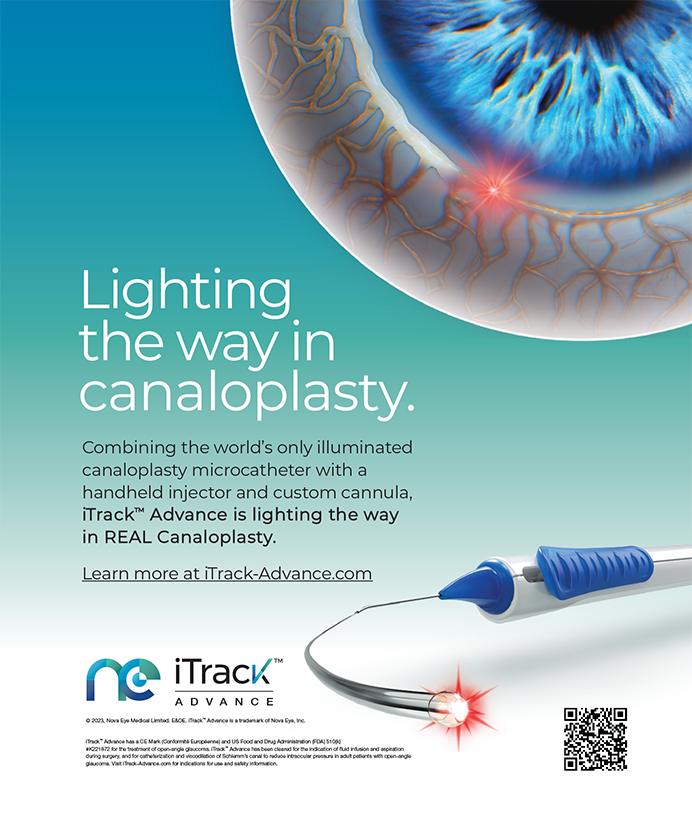
Evaluating Keratoconus Progression Prior to Crosslinking: Maximum Keratometry vs the ABCD Grading System
Vinciguerra R, Belin MW, Borgia A, et al1
Industry support: None for the study itself. M.W. Belin, Consultant (Oculus Optikgeräte); R. Riccardo, Consultant (Oculus Optikgeräte, Optimo Medical); P. Vinciguerra, Consultant (Oculus Optikgeräte, Schwind eye-tech-solutions)
ABSTRACT SUMMARY
Maximum keratometry (Kmax) is widely used as the cutoff parameter to determine keratoconus (KC) progression and the suitability of CXL treatment. The Belin ABCD Progression Display on the Pentacam (Oculus Optikgeräte) simultaneously measures the average anterior (A) and posterior (B) radii of curvature in a 3-mm optical zone centered on the thinnest point of the cornea (ThCT) and the minimum pachymetry reading (C). The D value is based on the BCVA.2
Study in Brief
A retrospective study of patients with progressive keratoconus (KC) found a moderately significant correlation between the change in maximum keratometry and the changes in the anterior and posterior radii of curvature between the day of CXL and the most recent clinical follow-up visit. The study also showed that patients already scheduled for CXL could have been identified for KC progression earlier with the use of the Belin ABCD Progression Display.
WHY IT MATTERS
The Belin ABCD Progression Display detected disease progression earlier than maximum keratometry alone in more than half of the cases of progressive KC in the study.
The retrospective study by Vinciguerra and colleagues included 76 eyes of 63 patients with progressive KC who were scheduled to undergo CXL. The aim was to evaluate the correlation between the changes in Kmax and ABC values. The Kmax, ABC values taken from the ABCD Progression Display, and ThCT were evaluated on the day of CXL (T0) and the most recent clinical follow-up visit (T-1). In patients without earlier documented progression in Kmax values, the change from an earlier examination (T-2) to T-1 was assessed when available.
Between T0 and T-1, the change in Kmax was moderately significantly correlated with the changes in the A and B values (P < .0001, r = 0.391 and P = .003, r = 0.339, respectively). No correlation was found between the changes in the C value and ThCT. The evaluation of T-2 showed that 51.6% of patients already scheduled for CXL could have been identified more than 5 months earlier with the use of the Belin ABCD Progression Display.
DISCUSSION
The early detection of KC progression is important because earlier intervention can preserve vision and reduce complications associated with CXL.3
Kmax is an objective and widely used index in the diagnosis of KC progression,4,5 but it is highly variable, especially in eyes with moderate to advanced cones.6 The Global Delphi Panel of Keratoconus and Ectatic Diseases suggested combining parameters from both the anterior and posterior cornea and corneal thickness.3 The Belin ABCD Progression Display relies on this excluded zone centered on the ThCT because the area represents the ectatic region.2
Vinciguerra et al showed a moderate yet statistically significant correlation between the change in Kmax and the changes in A and B values in progressive KC.1 Additionally, the study found that more than half of the progressive cases could have been identified earlier with the Belin ABCD Progression Display. The results indicate the limitations of relying on Kmax alone for detecting KC progression and suggest the potential for delayed intervention.
Detection of Postlaser Vision Correction Ectasia With a New Combined Biomechanical Index
Vinciguerra R, Ambrósio R Jr, Elsheikh A, et al7
Industry support: None for the study itself. R. Vinciguerra, P. Vinciguerra, C. Roberts, D. Kang, R. Ambrósio, and A. Elsheikh, Consultants (Oculus Optikgeräte)
ABSTRACT SUMMARY
The multicenter retrospective study sought to create and validate a biomechanical index using a large dataset with the goal of separating ectasia from stability in eyes that have undergone laser vision correction (LVC). Vinciguerra et al developed a combined biomechanical index (CBI-LVC) based on the Dynamic Corneal Response (DCR) parameters provided by a high-speed dynamic Scheimpflug camera (Corvis ST; Oculus Optikgeräte). The CBI-LVC included integrated inverse radius, applanation 1 (A1) velocity, A1 deflection amplitude, highest concavity and arc length, a deformation amplitude ratio of 2 mm, and A1 arc length in millimeters.
Study in Brief
Investigators developed a combined biomechanical index (CBI-LVC) to help distinguish between stable and ectatic post–laser vision correction (LVC) eyes. The CBI-LVC index combines Dynamic Corneal Response parameters provided by the Corvis ST (Oculus Optikgeräte). The index was shown to be highly sensitive and specific in differentiating stability from ectasia in post-LVC eyes.
WHY IT MATTERS
Current indices are useful for detecting the risk of ectasia before refractive surgery. The CBI–LVC appears to be highly sensitive and specific for separating stable eyes from ectatic eyes after they have undergone LVC.
The study included 736 eyes of 736 patients from different ethnic groups treated at 10 clinics on different continents. Six hundred eighty-five eyes were stable, and 51 were ectatic.
First, the optimum combination of parameters for the CBI-LVC was defined, and then its diagnostic capability was assessed. The receiver operating characteristic curve analysis showed an area under the curve of 0.991 and 0.998 when the CBI-LVC was applied to the validation and the training datasets, respectively. A cutoff of 0.2 separated stability from ectasia with a sensitivity of 93.3% and a specificity of 97.8%.
DISCUSSION
A careful assessment of topography, tomography, and corneal epithelial maps is required to identify post-LVC eyes that are at increased risk of developing ectasia.8 Many indices such as the keratoconus percentage index or KISA, Belin-Ambrósio deviation index or BAD-D, CBI, and tomography and biomechanical index or TBI have been created that have high sensitivity and specificity for detecting ectasia. These indices, however, detect the risk of ectasia before refractive surgery.9,10 After LVC, corneas are thinner and flatter than normal and are classified as abnormal by these algorithms. Corneal biomechanical changes are thought to occur before any changes to refraction, topography, tomography, and epithelial maps are detectable.11
Vinciguerra et al introduced the CBI-LVC index to separate stable post-LVC eyes from those with ectasia regardless of the type of LVC surgery performed.7 The index was shown to be highly sensitive and specific to distinguish post-LVC ectasia.
In the study by Vinciguerra et al, a large validation dataset confirmed the findings.10 The investigators recommended the use of the CBI-LVC, together with topography and tomography, in everyday clinical practice to support the diagnosis of post-LVC ectasia. The investigators noted that the index is for diagnosing post-LVC ectasia, not for predicting its later development.
1. Vinciguerra R, Belin MW, Borgia A, et al. Evaluating keratoconus progression prior to crosslinking: maximum keratometry vs the ABCD grading system. J Cataract Refract Surg. 2021;47(1):33-39.
2. Belin MW, Duncan JK. Keratoconus: the ABCD grading system. Klin Monbl Augenheilkd. 2016;233(6):701-707.
3. Gomes JAP, Tan D, Rapuano CJ, et al; Group of Panelists for the Global Delphi Panel of Keratoconus and Ectatic Diseases. Global consensus on keratoconus and ectatic diseases. Cornea. 2015;34(4):359-369.
4. Raiskup-Wolf F, Hoyer A, Spoerl E, Pillunat LE. Collagen crosslinking with riboflavin and ultraviolet-A light in keratoconus: long-term results. J Cataract Refract Surg. 2008;34(5):796-801.
5. Caporossi A, Mazzotta C, Baiocchi S, Caporossi T. Long-term results of riboflavin ultraviolet a corneal collagen cross-linking for keratoconus in Italy: the Siena eye cross study. Am J Ophthalmol. 2010;149(4):585-593.
6. Brunner M, Czanner G, Vinciguerra R, et al. Improving precision for detecting change in the shape of the cornea in patients with keratoconus. Sci Rep. 2018;8(1):12345.
7. Vinciguerra R, Ambrósio R Jr, Elsheikh A, et al. Detection of postlaser vision correction ectasia with a new combined biomechanical index. J Cataract Refract Surg. 2021;47(10):1314-1318.
8. Santhiago MR, Giacomin NT, Smadja D, Bechara SJ. Ectasia risk factors in refractive surgery. Clin Ophthalmol. 2016;10:713-720.
9. Ambrosio R Jr, Lopes BT, Faria-Correia F, et al. Integration of Scheimpflug-based corneal tomography and biomechanical assessments for enhancing ectasia detection. J Refract Surg. 2017;33(7):434-443.
10. Vinciguerra R, Ambrósio R Jr, Elsheikh A, et al. Detection of keratoconus with a new biomechanical index. J Refract Surg. 2016;32(12):803-810.
11. Koh S, Ambrosio R Jr, Inoue R, Maeda N, Miki A, Nishida K. Detection of subclinical corneal ectasia using corneal tomographic and biomechanical assessments in a Japanese population. J Refract Surg. 2019;35(6):383-390.




